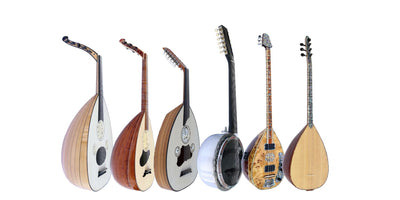

When the saz types are ordered from the largest to the smallest, they are listed as square saz, divan saz, çöğür, baglama, bad, minstrel saz, tambura, cura baglama, two-string saz, and cura. This difference is related to the fact that the saz narrates the nomadic lifestyles of the ancient Turks. The wood types used in reeds also differ. When we think of stringed instruments, the first thing that comes to mind is the saz. Saz's name is first encountered in 18th-century texts. This famous plectrum, which has been used for at least 1500 years, is still used by Central Asian and Siberian Turks, although it has left its place to baglama and family instruments in Anatolia today. Known as the ancestor of the plectrum instruments, Kopuz is one of the oldest instruments of the Turks. To recognize the baglama and its family saz, one must first identify the Kopuz, known as the ancestor of these instruments. Kopuz is known as the ancestor of plectrum instruments. İklıg is known as the ancestor of string instruments. They named the ones played with bows as İklıg, and the ones played with fingers or plectrums as Kopuz. People stretched thin skins on the upper part of the gourd and added stems, and bypassing the stringers over the skin, they made the sound clear.

To get to know the saz family, the Kopuz, known as the ancestor of these instruments, must first be recognized. Today, discussions continue about which tree the reed boat will be made of, how thin its cover, and how long its stem will be. The saz, which emerged after its evolution in Anatolia, was considered a sacred instrument by the Turkmens. These are from large to small Meydan Saz, Divan Saz, Çöğür (Bağlama), Bozuk, Cura and İkitelli are the instruments. Baglama saz family is available in various sizes. Minstrels have expressed people's love, sorrow, resentments, and happiness with Baglama they conveyed our tales the same way. It is known as baglama saz divan sazi (court saz), bozuk, üç telli (three-string), on iki telli (twelve-string), cögür, kopuz, cura, and tambura, etc. Ney has six holes in the front and one in the back.Saz (Baglama) has been the instrument of the minstrels in Turkey for centuries. Ney has a mouthpiece that creates a bowl-shaped cavity. It is an end-blown flute and difficult to play in an oblique in order to make it sound.

The Turkish ney is very popular in Sufi music.
TURKISH STRINGED INSTRUMENT SKIN
The five double strings are generally tuned as B2, E3, A3, D4, F#2 (or A2) and the low isolated string, called bam, is generally tuned as C#2 or D2.Īn interesting hybrid instrument of oud and banjo is the cumbus like the oud is fretles and like the banjo has a metal resonator and a skin body head.
TURKISH STRINGED INSTRUMENT PLUS
The Turkish oud has five double strings plus a single string at the low end. This characteristic feature allows to play all the complex pitch scales and nuances of the makams. The turkish oud is a bit smaller than the arabic oud, When we compare ouds with similar instruments like the European lute is the lack of frets. The oud is at the core of all middle eastern music and makam based music. It is important to make clear that Turkey is a very rich country in terms of musical traditions and its traditional musical instruments reflect the harmony of the cultures. Because you play it with your fingernails. Government asks him to join in fairs and exhibitions to show his best musical instruments. He is a master traditional musical instrument maker and player. Our artisan is carving all the musical instruments using musical golden ratio to get the perfect sound. This Three-stringed Cura is from juniper tree wood. Three-stringed Cura in Teke Region has varies in terms of structural and instrumental features. It has also different names like baglama curasi, tanbura curasi etc. One size bigger instrument than two-stringed cura gives a sound that is one octave lower This smallest member of stringed instruments family is in nearly every region of the country under a variety of names, including dede sazi, parmak cura, and iki and uc telli cura. Three-stringed Cura is the smallest member of the stringed instruments family with the highest pitched sound. It is the father of many saz instruments. Best musical instruments are those small curas to carry with and They have traditional playing techniques. Three-stringed Cura is traditional musical instrument that is generally in Teke Region in Turkey.


 0 kommentar(er)
0 kommentar(er)
